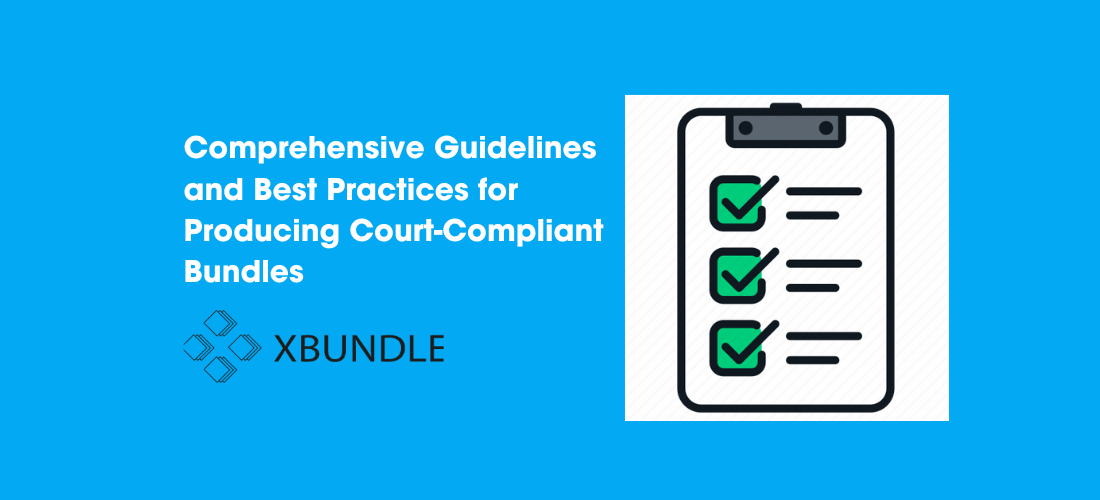Requirements and best practice for producing bundles
General guidance on bundles
-
- No hard copy bundles should be filed with the Court, only electronic bundles, unless requested by the judge.
- It is the duty of all legal representatives to co-operate at a high level for the preparation of bundles.
- For trial bundles, and any matter where it would be useful, a core bundle should be provided containing the key documents in the case.
- The file name for each .pdf file of the bundle, should contain the Claim No., a short version of the name of the case, and an indication of the number/letter of the bundle(s) e.g. Bundle A CL-2024-000123, Smith v Jones.
Format of Court compliant bundles
-
- Hearing bundles, other than the core bundles and authorities bundle(s), should be combined into one single .pdf file.
- In large case, it may be sensible to combine separate categories or sections of the bundle into separate .pdf files (especially if the single .pdf file is larger than 500MB).
- Each bundle should have a hyperlinked and searchable index.
- Chronological bundles of contemporaneous correspondence need not be indexed if an index is unlikely to be useful.
- All documents in the bundle should be bookmarked for ease of navigation. The bookmark should match the entry in the index and should contain the page number of the document.
- No more than one copy of any one document should be included, unless there is good reason for doing.
- Contemporaneous documents and correspondence should be included in chronological order.
- Bundles should be paginated clearly in the bottom right-hand corner.
- Pagination should begin afresh at the beginning of each bundle (page 1 of the index) and should correspond to the pages of the .pdf file.
- Where possible, page numbers should be preceded by the letter of the bundle.
- All documents, where possible, should be subject to OCR (optical character recognition) to ensure that the text in the document is word-searchable.
- Documents should generally appear in portrait mode – except documents that would be better read in landscape mode (for example cost budget documents , DRD and spreadsheets).
- The default view (zoom) for all pages should be 100 per cent.
Cross Margin Referencing
-
- Witness statements, affidavits, statement of case, and opening skeletons, unless clearly unnecessary, should contain cross margin referencing to show where the document referred to may be found.
- Unless otherwise agreed, it is the responsibility of the party that served the statement of case or witness statement to provide a cross referenced copy.
Authorities bundle(s) and core bundle
-
- Any authorities bundle(s) should be produced as a separate pdf document.
- Usually, Counsel will create the authorities bundle(s), but the legal team will be responsible for any updates and amendments.
- If there is more than one authorities bundle, these should be provided as a combined single .pdf file.
- Authorities bundle(s) should be separately paginated.
- All authorities in the bundle should be bookmarked for ease of navigation. The bookmark should match the entry in the index and should contain the page number of the document.
- A separate hyperlinked index should be provided.
- A core bundle should always be produced as a separate pdf document.
- A core bundle should be separately paginated, but each page should also bear its main bundle and page number reference.
- A core bundle should be lodged with the Court , or provided directly to the judge’s clerk, at the latest by 4pm on the working day before the first reading date for the trial or application hearing.
- All key documents should be bookmarked for ease of navigation. The bookmark should match the entry in the index and should contain the page number of the document.
- A separate hyperlinked index should be provided.
Delivery of bundles for hearings
-
- All documents should be delivered:
-
-
- by upload to CE file, if possible (which may depend on file sizes);
- by email to the judge’s clerk either (a) attaching the bundle(s) or (b) giving access to a secure download site;
- by using the Document Upload Centre by prior arrangement with the Court
- by providing the judge with personal secure and confidential access to shared digital workspace hosting the case materials.
-
-
- Where file sizes are large, the temptation to break sensibly bundled documents into smaller bundle just for ease of transmission should be avoided.
- The maximum aggregate size of attached files capable of being received is 36MB (justice,gov email addresses) or 150MB (ejudiciary.net email addresses).
- If bundles are transmitted by email, the email subject line should provide the following detail:
- All documents should be delivered:
(1) Case number,
(2) Case name (short version)
(3) Hearing date
(4) Judge name (if known) ; and
(5) The words in capitals “REMOTE HEARING” where applicable.
5. Once a bundle has been served on the Court, it should not be assumed that a substitute bundle will be accepted, because the judge may have started to mark up the original.
6. Any further documents should be provided separately, in a separate .pdf file.


